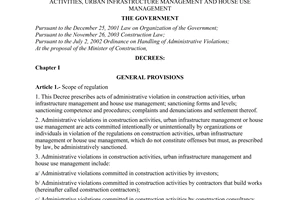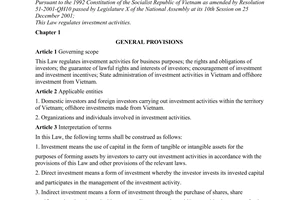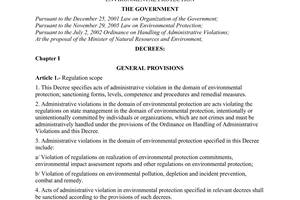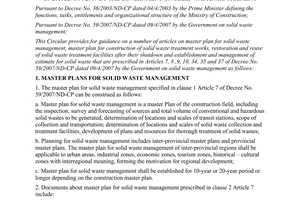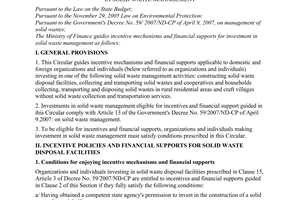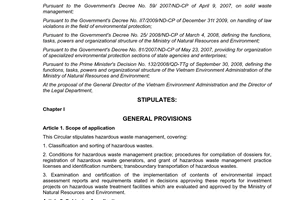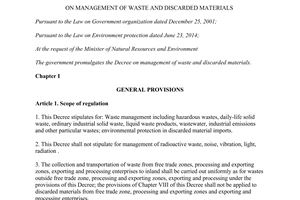Nội dung toàn văn Decree of Government No. 59/2007/ND-CP of April 09, 2007 on solid waste management
|
THE
GOVERNMENT |
SOCIALIST
REPUBLIC OF VIET NAM |
|
No.59/2007/ND-CP |
Hanoi, April 09, 2007 |
DECREE
ON SOLID WASTE MANAGEMENT
THE GOVERNMENT
Pursuant to the December 25,
2001 Law on Organization of the Government;
Pursuant to the November 29, 2005 Law on Environmental Protection;
Pursuant to the November 26, 2003 Law on Construction;
At the proposal of the Minister of Construction.
DECREES:
Chapter I
GENERAL PROVISIONS
Article 1.- Scope of application
This Decree provides for solid waste management, rights and obligations of entities engaged in solid waste-related activities.
Article 2.- Subjects of applications
This Decree applies to domestic organizations, households and individuals and foreign oragnizations and individuals (hereinafter referred to as organizations and individuals for short) engaged in solid waste-related activities in the Vietnamese territory.
If a treaty to which the Socialist Republic of Vietnam is a contracting party contains provisions differrent from those of this Decree, that treaty will prevail.
Articles 3.- Interpretation of terms
In this Decree, the terms below are construed as follows:
1. Solid waste management means activities of planning, managing, investing in building solid waste management facilities, separating, collecting, storing, transporting, reusing, recycling and disposing of solid waste in order to prevent and minimize adverse impacts on the environment and human health.
2. Solid waste means waste in a solid form, discharged from production, business, service, daily life or other activities. Solid waste includes ordinary solid waste and hazardous solid waste.
Solid waste generated in daily-life activities of individuals, households or at public places is collectively referred to as daily-life solid waste. Solid waste generated in industrial production, craft villages, business and service activities or order acivities is collectively referred to as industrial solid waste.
3. Hazardous solid waste means solid waste containing substances or compounds that exhibit any of the characteristics of radioactivity, ignitability, explosiveness, corrosiveness, infectiousness, toxicity or other hazardous characteristics.
4. Scrap means products and materials discarded from production or consumption and recovered for reprocessing or reuse as input materials for the production of the products
5. Collection of solid waste means activities of gathering, separation, packing and temporarily storing solid waste from different collection depots to a place or facility recorgnized by a competent state agency.
6. Storage of solid waste means the keeping of solid waste for a given period of time at a place recognized by a competent agency before solid waste is transported to a processing facility.
7. Transportation of solid waste means the process of carrying solid waste from a place of generation, collection, storage or transfer to a place of processing, recycle or reuse or to a final landfill.
8. Place or facility recorgnized by a competent agency means a place of storage, disposal or burial of solid waste approved by a competent state management agency.
9. Processing of solid waste means the process of applying technological and technical solutions to reduce, remove or destroy harmful or useless constituents of solid waste; and to recover, recycle or reuse constituents of solid waste.
10. Sanitary landfill of solid waste means burying solid waste in accordance with requirements of technical standards on sanitary landfills for solid waste.
11. Waste generator means an organization, individual or household angaged in activities that generate solid waste.
12. Solid waste colector or transporter means an organization or individual licensed to conduct the collection or transportation of solid waste.
13. Solid waste disposal facility owner means an organization or individual licensed to dispose of solid waste. A solid waste disposal facility owner may be the investor of a solid waste disposal facility or a professionally qualified organization or individual and hired by the investor to operate the solid waste disposal facility.
14. Solid waste management facility means material foundation, technical chain and equipment used in the collection, separation, transportation, processing and disposal of solid waste.
15. Solid waste disposal facility means material foundation including land, workshops, technological chain, equipment and auxiliary structures used in activities of disposing of solid waste.
16. Solid waste management facility investor means an organization or individual licensed to invest in activities of collecting, separating, transporting, processing or disposing of solid waste.
17. Solid waste disposal complex means a combination of one or more works for disposal, recycle or reuse of solid waste and one or more solid waste landfills.
18. Expenses for solid waste disposal means expenses for ground clearance, construction investment, procurement of vehicles and eqiupment, labor traning, management and operation of a solid waste disposal facility, which are calculated according to the duration of capital retrieval and perdisposal solid waste quantity unit.
19. Expenses for collection and transportation of solid waste means expenses for vehicles and equipment, labour traning, management and operation of the facility for the collection and transportation of solid waste, which are calculated according to the duration of capital retrieval and per collected or transported solid waste quantity unit.
Article 4.- Principles for solid waste management
1. Organizations and individuals that discharge solid waste or are engaged in activities that generate solid waste shall pay charges for the collection, transportation and disposal of solid waste.
2. Waste shall be separated at source of generation, recycled, reused, processed and have its usefull constituents recovered for use as input materials and energy generation.
3. To prioritize the application of technologies of processing hard-to-decompose solid waste which may help reduce the colume of waste to be buried, so as to save land used for this purpose.
4. The State encourages the socialization of the collection, separation, transportation and disposal of solid waste.
Article 5.- Contents of state management of solid waste
1. Promulgating policies and legal documents on solid waste management, disseminating, popularizing and educating about the law on solid waste management and guiding the implementation of these documents.
2. Promulgating technical specifications and standards applicable to solid waste management.
3. Managing the elaboration, approval and announcement of plans on solid waste management.
4. Managing the investment in solid waste collection and transportation and building of solid waste disposal facilities.
5. Inspecting, overseeing and handling law violations in the course of solid waste management.
Article 6.- Prohibited acts
1. Placing solid waste not at prescribed places.
2. Emitting dust, dropping solid waste in the course of collection and transportation.
3. Mixing non-hazardous solid waste and hazardous solid waste
4. Illegally importing or transiting solid waste in the Vietnamese territory.
5. Obsrtucting the collection, transportation and disposal of solid waste under projects approved by competent agencies.
6. Othes prohibited acts under law.
Chapter II
PLANNING ON SOLID WASTE MANAGEMENT, INVESTMENT IN SOLID WASTE MANAGEMENT
Section 1. PLANNING ON SOLID WASTE MANAGEMENT
Article 7.- Contents of planning on solid waste management
1. Planning on solid waste management covers investigation, survey, forecasting of generation sources and total volume of solid waste to be generated, determining locations and sizes of solid waste collection depots, transfer stations, transportation routes and disposal facilities; determination of solid waste collection and disposal methods, elaboration of plans and development or human resources for thorough disposal of solid waste.
2. Contents of planning on solid waste management:
a. Investigating, surveying, forecasting generation sources, composition, charateristics and total vollume of ordinary and hazardous solid waste;
b. Assesing the capacity to separate solid waste at source and the capacity to recycle and reuse solid waste;
c. Determining locations and sizes of solid waste collection depots and transfer stations, disposal facilities and landfills;
d. Determining criteria for selection of solid waste disposal technologies;
f. Elaborating plans on and developing human resources for making adequate statistics and thoroughly disposing of all types of solid waste.
Article 8.- Requirements for planning on building of solid waste transfer stations, disposal facilities and appurtenances
1. The planning on building of solid waste transfer stations and disposal facilities must be in line with the regional construction planning ang the solid waste management planning approved by competent authorities.
2. Solid waste transfer stations shall be located in easily accessible areas, and must neither obstruct public traffic nor adversely affect the environment and urban landscape.
3. The planning on building of solid waste disposal facilities and appurtenances must comply with legal provisions on construction planning and concurrently satisfy the following requirements:
a. Regarding positions and geological, topgraphical and hydrological conditions:
- Being loacated at a appropriate distance from waste generation sources;
- Being safely segragated from nearest residential areas, urban centers, entertainment and recreation areas, tourist sites, historical and cultural relics , airports, water sources, rivers, lakes and seashores;
- Having appropriate geological and hydrological conditions; lying outside deeply submerged areas, flood-diverging areas of river basins, headwater areas, karst regions and tectonic crackings.
b. The sizes of solid waste disposal facilities and appurtenances are detemined on the basis of:
- Population size, present waste amount and operation duration, taking into consideration the population growth and corresponding increase in solid waste amount;
- Projected economic growth rate and urban development orientation throughout the course of operation of solid waste disposal facilities and appurtenances;
- Expected solid waste disposal technologies.
c. Regarding plans on reuse of grounds after the closure of landfills:
Upon planning the building of solid waste disposal facilities, the possilibity of reusing grounds after the closure of landfills shall be taken into consideration.
Article 9.- Solid waste disposal facilities and appurtenances
1. Solid waste disposal facilities may be located in different ways, depending on technologies ecpected to be applied and actual conditions, including:
a. Concentrated facilies: One or more solid waste disposal facilities and qppurtenances shall be located in a planned area. Solid waste disposal facilities may be:
- Ordinary garbage incinerators;
- Garbage incinerators with energy recovery;
- Organic fertilizer plants;
- Plants producing input materials and products from waste;
- Sanitary landfills for ordinary solid waste;
- Landfills for hazardous solid waste;
- Solid waste disposal complexes
b. Scattered facilities: Solid waste disposal work items and appurtenances may be located at different places as appropriate;
c. For rural residential areas, deep-lying and remote areas: To apply forms of combined gardens, fish ponds and stables, home-made garbage cans and cellars, auto-decomposition cesspools, mud-coated compost sumps, etc., for household use for the puspose of disposing of solid waste discharged from daily life, cultivation and husbandry.
2. The Ministry of Construction shall guide the planning on building of solid waste disposal works, reuse of grounds of solid waste disposal facilities and appurtenances after those facilities and works terminate their operation.
Article 10.- Responsibility to organize the elaboration, approval and management of solid waste management plannings.
1. Regional, inter-provincial and inter-municipal solid waste management plannings and those of Key economic regions shall be approved by the Prime Minister or the Minister of construction under the Prime Minister’s authorization.
The Ministry of Construction shall assume the prime responsinbility for, and coordinate with provincial/municipal People’s Committees (hereinafter referred to as provincial-level People’s Committees) and concerned branches in, organizing the elaboration of regional, inter-provincial or inter-municipal solid waste management plannings or those of key economic regions.
2. Local solid waste management plannings shall be elaborated and approved by presidents of provincial-level People’s Committees.
3. The Ministry of Defense shall assume the prime responsibility for, and coordinate with concerned ministries, branches and localities in, elaborating and approving plannings on building and management of sites for disposal and destruction of explosive materials and hazardous waste discharges from military and defense activities.
4. Solid waste mansgement plannings of all levels shall be publicy announced according to legal provisions on construction planning.
Article 11.- Funds for solid waste management planning work
1. Funds for the elaboration of the solid waste management planning come from:
a. The state budget;
b. Other lawful sources.
2. Management of state budget funds for solid waste management planning work:
a. Funds for solid waste management planning wors at regional, inter-provincial or inter-municaipal level or in key economic regions shall be estimated and incorporated by the Ministry of Construction in annual state budget capital plans;
b. Provincipal-level People Committees shall aleborate plans on funds for solid waste management planning work within administrative units under their management;
c. The ministry of Planning and Investment and the Ministry of Finance shall allocate annual state budget funds for solid waste management planning work according to the provisions of the Law on the State Budget.
Section 2. INVESTMENT IN SOLID WASTE MANAGEMENT
Article 12.- Investment principles
1. The State encourages all forms of investment in the domain of solid waste, including: business cooperation contract (BBC), build-operate-transfer (BOT), build-transfer-operate contract (BTO), build-transfer contract (BT), acquisition of enterprises, purchase of bonds, investment in securities and other investment forms under the Investment Law.
2. Investment in solid waste management shall be made in a coordinated manner to help thoroughly treat solid waste and ensure socio-econimic efficiency and environmental protection requirements.
3. Investment in the collection and transportation of solid waste and building of solid waste transfer stations and disposal facilities shall be made in accordance with the law on investment and construction.
Article 13.- Investment insolid waste management
1. Contents of investment in the building of solid waste disposal facilities:
a. Investing in building all or some work items of solid waste disposal facilities;
b. Procuring technologies, equipment and supplies to serve the solid waste disposal;
c. Investing in research, development and improvement of solid waste disposal technologies.
2. Contents of investment in the collection and transportation of solid waste:
a. Investing in the procurement of equiment, special-use vehicles and other devices to serve the collection and transportation of solid waste;
b. Investing in the building of solid waste transfer stations.
1. The State encourages the socialization of investment in the solid waste collection and transportation and the building of sollid waste management facilities on the principles specified in Article 12 and by the following methods:
a. Organizations and individuals may invest in solid waste management according to one or all contents specified in Clauses 1 and 2 of this Article;
b. Organizations and individuals may invest in the establishment of cooperatives, business households or other entities defined by law to collect, transport, process and dispose of solid wastein rural residential areas and craft villages where no solid waste collection and transportation services are provided.
Article 14.- Investment capital sources and investment incentives
1. Capital for investment in building solid waste disposal facilities and appurtenances comes from the central budget, local budgets, foreign aid, long-term loans and other lawfull capital sources.
2. The State encourages all organizations and individuals at home and abroad to participate in investing in and building solid waste disposal facilities and appurtenances through the following investment incentive and support policies:
a. Exemption of land use levy, payment of expenses for ground clearance compensation;
b. Investment supports from the bugdet sources and preferential credits; post-investment interest rate subsidies for borrowers of commercial loans;
c. Securiry for preferential credit loans mortgaged with assets formed from borrowed capital;
d. Import tax exemption for equipment, raw materials and materials of investment projects on solid waste disposal facilities, and business income tax exemption or reduction according to current regulations;
e. Prioritized selection of home-made complete technologies which are capable of thoroughly treating solid waste and bringing about high techno-economic efficiency;
f. Suport investment in technical infrastructure systems, including transport, power supply, energy supply, information and communication, water supply and drainage systems up to the fences of projects:
g. Assistances for research and development of technologies for re-processing, reuse and disposal of solid waste from domestic resources. Funding sources for assistance for technological research and development come from the state budget through scientific and technological programs and projects;
h. Assistance for labor training from budget capital sources through training assistance programs.
3. The Ministry of Finance shall guide the mechanism of financial preferences and aid for the socialization of investment in solid waste management.
4. The Ministry of Natural Resources and Environment shall formulate and promulgate preferential land policies for solid waste management.
Article 15.- Investors of solid waste management facilities
1. Investors of solid waste management facilities are persons who own capital or are authorized to manage and use capital to invest in solid waste management facilities.
2. For projects funded with the state budget, investors of solid waste management facilities are decided by investment deciders before investment projects are formulated.
3. For projects funded with credit capital, investors are borrowers.
4. For projects funded with capital of other sources, investors are capital owners or their representatives at law.
5. For projects funded with syndicated capital, investors are appointed by capital contributors rthrough agreeement or are parties with the highest capital contribution proportion.
Article 16. Investment projects on building solid waste management facilities
1. Investment in solid waste management facilities covers the contents specified in Article 13 of this Decree. The formulation, elaboration and approval of investment projects on building solid waste management facilities shall be made in accordance with the law on investment in construction of works..
2. For investment projects on building solid waste disposal facilities, apart from the contents specified by the law on construction investment, their contents cover:
a. Technological solutions to dispose of solid waste; technological solutions to treat leachate and wastewater discharged from the disposal of solid waste; efficiency of solid waste disposal technoligis;
b. Measures to ensure safety in the course of operation; solution to respond to environmental incidents;
c. Environmental observation plans and programs;
d. Plans on restoration of environmental landscape after the of landfills or termination of operation of solid waste disposal facilities;
e. Proposals on investment incentives for projects;
f. Economic-financial contents:
- Total investment in building solid waste disposal facilities;
- Capital sources and capability to supply capital according to the progress of projects;
- Expences for disposal of ordinary and hazardous solid waste (exclusive expenses for collection and transportation);
- Proceeds from the sale of recycled or reused products;
- Support funds from the state budget through collectors or transporters to pay expenses for daily-life solid waste disposal as committed by local administration;
- Charges payable to disposal facility owners for ordinary or hazardous solid waste as committed by collectors or transporters;
- Recoverability of investment capital.
g. Responsibilities and inverstment incentives for projects, solid waste sources for the operation of disposal facilities as committed by local administrations.
3. Apart from the contents specified by investment law, investment projects on collection or transportation of solid waste must contain the following contents:
a. Scope of collection, projected amounts of various types of solid waste;
b. Equipment and vehicles used for solid waste collection and transportation; safety and labor protection devices for laborers;
c. Plans on investment in transfer stations;
d. Plans on organization, management and direction of solid waste collection and transportation;
e. Safety measures, plans on response to environmental incidents caused by collection or transportation activities;
f. Proposal of investment incentives; investment incentives committed by local administrations;
g. Economic-financial contents:
- Total investment capital;
- Capital sources and capability to supply capital according to the progress of projects;
- Expenses for solid waste collection and transportation;
- For daily-life solid waste: Support funds from the state budset to pay charges for collectors and transporters as committed by local administrations and collected sanitation charges according to regulations;
- Recoverability of investment capital.
4. The Ministry of Science and Technology shall assume the prime responsibility for, and coordinate with the Ministry of Construction in, organizing the assessment of solid waste disposal technologies reseached and developed for the first time in Vietnam.
Article 17. Responsibilities and benefits of investors of solid waste disposal facilities
1. Responsibilities:
a. To invest in building solid waste disposal facilities and appurternances in strict compliance with the law on construction investment;
b. To pay compensation and expenses for ground clearance, relocation of graves, or to provide job-change supports according to law for inhabitants in areas where projects are implemented;
c. To comply with the contents and order of construction investment specified by law when wishing to change construction investment contents or alter technologies.
2. Benefits:
a. To sell and enjoy benefits from products of solid waste disposal activities under investment projects;
b. To enjoy the State’s prefrential and support policies according to Clause 2, Article 14 of this Decree and other relevant legal provisions;
c. To transfer solid waste disposal facilities and relevant appurtenances;
d. To enjoy other benefits provided by relevant law.
Article 18.- Transfer of solid waste disposal facilities
1. Investors may transfer their solid waste disposal facilities and appuurtenances to new investors according to law.
2. New investtors shall comply with the provisions of Article 17 of this Decree and revelant legal provisions.
3. New investors are entitled to preferences provided for in Clause 2, Article 14 of this Decree.
Chapter III.
SEPARATION OF SOLID WASTE
Article 19. Source separation of solid waste.
1. Ordinary solid waste shall be controlled and separated at source and stored in bags or tanks of given colors as specified by law.
2. Hazardous solid waste shall be separated at source and separately stored according to regulations, and shall not be mixed with ordinary solid waste. Mixed hazardous and ordinary solid waste shall be disposed of like hazardous solid waste.
3. Organizations and individuals engaged in activities that generate solid waste shall separate solid waste at source according to Article 20 of this Decree.
Article 20. Separation of ordinary solid waste
1. Ordinary solid waste from all diffirent generation sources are separates into two principal groups:
a. Group of wastes which are recoverable for reuse or recycle; scraps discarded from production; household and industrial electric and electronic appliances, discarded means of transport and products used for production and consumption; used paper, metal, glass or plastic containers and packing, etc…;
b. Group of wastes which shall be processed or buried: organic waste ( trees, tree leaves, vegetables, foods, carcass, etc…); consumer goods containing toxic chemicals ( batteries, accumulators, lubricating oil and grease, etc.); and other non-reusable solid waste.
2. Construction solid waste, such as sludge, soil, stone and other construction, and demolition debris, ect.., which shall be separated:
a. Soil and sludge from the excavation and dredging of surface soil layer, which can be used to fertilize cegetation soil;
b. Soil, stone, soil waste from construction materials (bricks, roofing tiles, mortar, concrete and discarded adhesive materials ) which are recyclable or reusable as filling materials for construction works;
c. Solid wastes like broken glass, discarded iron and steel, dead wood, paper and plastic bags which are recyclable or reusable.
Article 21. Separation of hazardous solid waste
1. Minstries and branches shall guide the separation and preservation of hazardous solid waste from production, service, reseach and experimental acticities of sectors under their management to serve the solid waste collection and separation.
2. The Ministry of Natural Resources and Environment shall promulgate the list of hazardous waste.
Article 22. Responsibilities and obligations of ordinary solid waste generators
1. Reaponsibilities and obligations of individuals and households:
a. All individuals shall place solid waste at prescibed point at public places according to regulations;
b. Households shall separate and put solid waste in sanitary containers or in bag of given colors, or dump them at prescribed sites;
c. Households, when conducting renovation or demolition of construction works, shall register with urban environment companies or directly contract with licensed construction solid waste transportation units to dump their waste at prescribed sites;
d. Households in urban centers and craft villages that organize production at their residences shall separate their waste and enter into contracts with solid waste collectors, transportors and disposal facility owners;
e. Households in rural, deep-lying and remote areas where collection systems are unavailable shall dispose of their solid waste under the local administration’s guidance and may not dump them onto roads, into rivers, streams, canals and ground water sources. Packing of used toxic chemicals or dicarded chemical products for agricultural or forestry production shall be stored in separate bags, separately collected, transported and disposal of;
f. To pay sanitation charges set by local administrations.
2. Responsibilities and obligations of agencies, trade or service establishments, industrial production establishments and craft villages:
a. To collect and separate ordinary solid waste at source with sanitary tools under the guidance of collectors and transporters;
b. To enter into contracts for solid waste collection, transportation and disposal services; to pay full service charges as contracted.
Article 23. Responsibilities of hazardous solid waste generators
1. Responsibilities of hazardous solid waste generators:
a. To make registration with local state agencies in charge of environmental protection;
b. To separate, pack, preserve and store hazardous solid waste at their establishments according to regulations on hazardous solid waste management before it is transported to disposal facilities according to regulations. Hazardous solid waste shall be labeled with necessary information according to regulations.
2. The Ministry of Natural Resources and Environment shall guide the registration of hazardous solid waste generators.
Chapter IV
COLLECTION, STORAGE AND TRANSPORTATION OF SOLID WASTE
Article 24. Collection, storage and transportation of ordinary solid waste
1. The collection, storage and transportation of ordinary solid waste shall be conducted by service companies, service cooperatives or households (hereinafter referred to as solid waste collectors and transporters) under service provision contracts.
2. Ordinary solid waste in urban centers shall be collected along specified routes and by methods in conformity with approved solid waste management plannings.
3. Solid waste containers shall be installed along main roads, in commercial areas, parks, square densly populated areas, traffic hubs and other public places.
4. The capacity of waste tanks installed inside construction works must be suitable to the waste-storing duration. Waste containers installed at public places must be up to technical standards and ensure public beauty.
5. The solid waste storing duration shall not exceed two days.
6. Vehicles used for solid waste transportation must be special-use ones that satisfy technical and safety standards, have been tested and licensed by functional agencies for operation.
7. In the course of solid waste transportation, it is prohibited to leak or drop waste, emit dust or smell
Article 25. Collection, storage and transportation of hazardous solid waste
1. Collection, storage and transportation of hazardous solid waste shall be conducted by organizations with appropriate capability and hazardous waste management practice licenses granted by a competent state agency.
2. Hazardous solid waste generators may organize by themselves the collection, storage and transportation of their waste to disposal facilities if they are able to do so and licensed by a compete at state agency. Hazardous solid waste generators that are incapable of collecting, storing and transporting their waste shall enter into contracts with licensed organizations to do so.
3. Ministries and branches shall guide the onsite collection and storage of hazardous solid waste in production establishments, craft villages, medical establishments and research and experiment institutions under their management.
4. The Ministry of Natural Resources anh Environment shall specify the condition of capability and guide the grant of licenses for practicing hazardous waste management.
Article 26. Responsibilities of ordinary solid waste collectors and transporters
1. To ensure sufficient personnel and vehicles for the collection and transporation of the whole solid amount at prescribed places
2. To install solid waste tanks at prescribed places; to supply waste bags to households and guide households, organizations and individuals that generate solid waste in conducting the source separation of waste.
3. To publicly announce the solid waste collection schedule, places and routes in residential areas.
4. To collect solid waste and transport it to prescribed places.
5. To bear responsibility for the dropping of solid waste and dispersion of smell, thus causing adverse environmental impacts in the course of collection and transportation.
6. To professionally train and equip labor protection devices for solid waste collection and transportation workers.
7. To organize periodical health checks for their employees.
8. Other responsibilities specified by public-utility service contracts.
Article 27. Responsibilites of hazardous solid waste collectors and transporters
1. To ensure sufficient collection equipment, vehicles and other safety devices in order to transport the whole amount of hazardous solid waste to the prescribed places under service contracts signed with waste generators.
2. To ensure that their solid waste collection equipment and vehicles meet technical requirements for operation, and are registered and permitted for road or waterway operation according to traffic regulations.
3. To repair, maintain and clean solid waste collection equipment and vehicles.
4. To ensure that personnel managing or directly engaged in solid waste collection and transportation are fully qualified and trained in management and operation of equipment and vehicles in order to ensure safety and environmental sanitation in the course of operation.
5. To equip labor protection devices and provide periodical health checks for laborers directly engaged in solid waste collection and transportation.
6. To bear responsibility for the dropping, leaking and dispersion of hazardous waste into the environment.
Article 28. Responsibilities of local administrations, mass organizations and population in solid waste collection and transportation.
1. Provincial-level and district-level People’s Committees shall organize solid waste management in their localities; publicly announce plannings on solid waste management; organize inspection, examination and handling of law violations in the domain of solid waste collection and transportation.
2. Commune-level People’s Committees, mass organizations and local people shall supervise the solid waste collection and transportation in their localities. Any detected law violations in solid waste management shall be reported to local competent agencies for handling according to law.
3. Contents of supervision of solid waste collectors and transporters:
a. The notified collection and transportation process: supply of waste bags; collection schedule, places and routes; places of transportation destination;
b. Requirements on assurance of environment sanitation in the course of solid waste collection and transportation;
c. Requirements on labor protection devices for labourers;
d. Collection of sanitation charges according to regulations.
Chapter V
DISPOSAL OF SOLID WASTE
Article 29. Solid waste disposal technologies
1. Technology of incinerating garbage to generate energy.
2. Technology of processing organic fertilizers.
3. Technology of processing biogases.
4. Technology of treating leachate.
5. Technology of reprocessing waste into building materials and products.
6. Technology of reusing useful constituents of waste.
7. Technology for for sanitary landfill of solid waste.
8. Technology for landfill of hazardous solid waste.
9. Other technologies.
Article 30. Selection of solid waste disposal technologies
1. The selection of solid waste disposal technologies shall be based on characteristics and composition of waste and specific conditions of localities.
2. It is encouraged to select complete and advanced technologies for recycle and reuse of waste to create raw materials and generate energy.
3. It is encouraged to apply advanced technologies so as to thoroughly dispose of waste, minimize solid waste volume to be buried, thus saving land used for disposal and ensuring environmental sanitation.
Article 31. Responsibilities of investors in the course of operation
1. Responsibilities:
a. To organize and operate solid waste management facilities according to the contents of their approved projects;
b. To pay taxs and fulfill financial obligations to the State according to law;
c. To take urgent measures to ensure safety for humans and property upon detecting environmental incidents; to organize salvation of humans and property, and promptly notify local administrations or specialized environmental protection bodies in localities where environmental pollutions or incidents occur for coordinated handling;
d. To send official letters to state management agencies in charge of environmental protection notifying the date their landfills are closed or their solid waste disposal facilities terminate operation, in case of closure of those landfills or termination of operation of those facilities;
e. To restore and improve the landscape of areas where their landfills or solid waste disposal facilities are located after the closure of those landfills or termination of operation of those facilities; and at the same time, to take measures to prevent environmental pollution;
f. To complete procedures for handing over land to the State within two years after the closure of landfills or within one year after the termination of operation of solid waste disposal facilities;
g. To observe the environment and monitor environmental changes for at least five years after the closure of landfills or termination of operation of solid waste disposal facilities. To notify environmental observation results to local state management agencies in charge of environmental protection;
h. When the land lease term expires, investors of solid waste disposal facilities and appurtenances shall ask state management agencies for an extension of the land lease term if they wish to continue their operation.
2. Benefits:
a. To enjoy the State’s support and preferences provided for in Clause 2, Article 14 of this Decree and other laws;
b. To be given priority in exploiting and using landfills after their closure and solid waste disposal facilities and appurtenances after terminating their operation.
Article 32. Responsibilities of solid waste diposal facility owners
1. Solid waste disposal facility owners may operate their facilities only when:
a. The work items of investment projects on building solid waste disposal facilities are completed, tested, accepted and put into operation according to the law on construction investment;
b. There are environmental supervision programs, plans and measures to ensure safety in course of operation;
c. For disposal of hazardous solid waste disposal facilities owners must possess practice licenses for disposal of hazardous solid waste granted by a competent state agency.
2. Responsibilities of solid waste disposal facility owners:
a. To receive and dispose of only types of solid waste stated in the projects from waste generators or collectors or transporters approved by competent authorities;
b. To operate solid waste disposal facilities according to the technological process stated in the projects and evaluated and approved by competent state agencies;
c. To record in writing and archive waste files and send biannual reports to state management agencies in charge of environmental protection;
d. To elaborate plans and programs and devise measures to prevent and respond to environmental incidents;
e. To organize the implementation of environmental supervision programs at their facilities. To send supervision programs and observation results to state management agencies in charge of environmental protection once every six months;
f. To implement labor safety plans in the course of operation and protect the health laborers.
Article 33. Observation of the environmental quality at solid waste disposal facilities.
1. Environmental observation shall be organized at solid waste disposal facilities and appurtenances of different sizes throughout the course of operation and five years after the closure of landfill or terminatioc of operation of facilities. At least once every six months, solid waste disposal facility owners shall conduct environmental observation.
2. Environmental observation shall be conducted for air environment and ecosystem, noise and vibration.
3. Observatories shall be located at typical sports from which environmental developments affected by solid waste disposal facilities can be observed. The observation position and frequency shall be indicated in environmental impact assessment reports evaluated and approved by a competent state agency.
4. Report on environmental observation results shall be sent to local state management agencies in charge of environmental protection.
Article 34. Restoration and reuse of ground areas after the closure of landfills or termination of operation of solid waste disposal facilities.
1. The restoration and reuse of ground areas after the closure of landfills or termination of operation of solid waste disposal facilities must satisfy the following requirements:
a. Survey and assessment of relevant environmental elements are conducted before ground areas are reused;
b. Leachate and waste gases are normally treated pending the reuse of ground areas of landfill;
c. Environmental changes shall be monitored at observatories after the closure of landfills and termination of operation of solid waste disposal facilities;
d. Topographical maps of ground areas shall be made after the closure of landfills and termination of operation of solid waste disposal facilities;
e. Measures to control the environment for subsequent years are proposed;
f. Dossiers on handover of ground areas to competent state agencies for continued management and use are made;
g. Upon reuse of ground areas of landfills, before holes for gas collection are carefully checked. Only when the presure at these holes is less tan 5% higher or lower than the atmospheric presure and the gas concentration, can the ground leveling be conducted.
2. Procedures for closure of solid waste landfills, termination of disposal operation and conversion of the land use purpose:
a. Restoring and improving environmental landscape in solid waste disposal areas and landfills;
b. Within six months after the closure of landfills, investors of solid waste disposal facilities shall report to state management agencies in charges of environmental protection on the actual state of those landfills and appurtenances. Such a report shall be made by a professionally qualified organization and must contain the follwing:
- The actual operation state, efficiency and operration capacity of all works in the landfill, including cutoff system, leachate collection and treatment system, groud and underground water management system, gas collection system, underground water quality control system, etc…;
- Results of observation of the quality of leachate from the ladfill into the environment, underground water quality and environment;
- Compliance with current regulations as well as restoration and improvement of landscape in the landfill site. The report must clearly identify failures to comply with current regulations and propose handling messures;
- Drawings of the actual state of the solid waste disposal facility and landfill.
c. After landfills are closed, humans and animals are not allowed to freele enter those landfills, especially on their tops where gases are concentrated; and there must be signboards and safety intructions in these landfills.
3. Before handing over ground areas to competent agencies, investors of solid waste disposal facilities shall make and send archival dossiers to local archive aencies according to legal provisions on archive. An archival dossier contains:
a. Documents on geo-technical measurement and survey;
b. The whole construction investment project dossier, completion drawings of construction items of the solid waste disposal facility;
c. Books and records for monitoring the receipt and disposal of solid waste throughout the course of operation;
d. Periodical reports on environmental supervision;
e. Plan on the closure of the landfill and the termination of operation of the facility;
f. Plan on environmental protection;
g. Plan on observation and monitoring of quality of the environment;
h. Report on results of assessment of the actual state of the environment at the solid wasrte disposal facility at the time of closure and operation termination;
k. Other relevant documents.
4. The Ministry of Construction shall assume the prime responsilility for, and coordinate with the Ministry of Natural Resources and Environment in, guiding the restoration and reuse of ground areas, conversion of the land use purpose and environmental observation of solid waste disposal facilities after their operation is terminated.
Chapter VI
EXPENSES FOR SOLID WASTE MANAGEMENT
Article 35. Management of construction investment expenses and solid waste disposal expenses.
1. Expenses of investment projects on building solid waste disposal facilities funded with the state budget shall be managed according to the law on construction and relevant laws.
2. For daily-life solid waste, disposal expenses are covered the state budget, apart from sanitation charges collected from waste generators. Disposal facility owners shall collect charges from collectors and transporters under service contracts.
3. For industrual solid waste, disposal expenses are paid directly by waste generators (if waste generators transport their waste directly to disposal facilities or disposal facility owners provide package services of collection, transportation and disposal) or through collectors or transporters.
4. Solid waste disposal expenses covered by the state budget shall be managed according to current regulations. The Ministry of Construction shall guide mothods of elabrating and estimates of charges for public-utility services of solid waste disposal.
5. Provincial-level People’s Committes shall elaborate and promulgate public-utility service charge rates for application in their respective localities.
Article 36. Management of solid waste collection and transportation expenses
1. Expenses for daily-life solid waste collection and transportatioc services covered by the tate budget shall be managed according to law.
2. For daily-life solid waste, apart from sanitation charges collected according to regulations, local administrations shall use local budgets to compensate for expenses paid by collectors and transporters under service contracts.
3. For industrial solid waste, waste generators shall:
4. Pay collection, transportation and disposal expenses to collectors and transporters under service contracts;
a. Pay collection, transportation and disposal expenses directly facility owners of the latter perform package service contracts;
b. Provincial-level People’s Committees shall promulgate charge rates and approve estimates of charges for solid waste collection and transportation services to serve as a basis for bidding for provision of public-utility services funded with the state budget.
Article 37. Solid waste management service contracts
1. Solid waste management service contracts may take the following forms:
a. Solid waste collection, transportation and disposal service contract;
b. Solid waste collection and transportation service contract;
c. Solid waste disposal service contract.
2. Value of service contracts:
a. For daily-life waste, the value of a service contracts is detemined on the basic of charge estimates approved by a mopetent authority or through service bidding results;
b. For industrial solid waste, the value of a service contract is agree elaborated by the collector, transporter or disposal facility owner.
Chapter VII
INSPECTION, EXAMINATION, AND HANDLING OF VIOLATIONS
Article 38. Inspection and examination
1. Environment inspectorates at all levels shall perform the funtions of inspecting, examining and handling violations in solid waste management. Contents, forms and methods of environmental inspection are as defined in the Government’s Decree No. 65/2006/ND-CP of June 23, 2006, on organization and operation of the Natural Resources and Environment Inspectorate.
2. Organizations, individuals and household shall promptly detect, stop or report to local administrations on acts of law violation in solid waste management.
Article 39. Handling of violations
1. Organizations, individuals and households that commit acts violation of the provisions of this Decree shaall, depending on the nature and severity of their violations, be administratively sanctioned according to the Government’s Decree No. 126/2004/ND-CP of May 26, 2004, on sanctioning of administrative violations in construction and management of urban infractructure works and management of use of house, and the Government’s Decree No. 81/2006/ND-CP of August 9, 2006 on sanctioning of adminstrative violations in the domail of the environmental protection, or pay compensations for damage according to law.
2. Organizations, individuals and households that intentionally commit acts of violation, thereby causing serious environmental consequences, may be examined for penal liability according law.
Chapter VIII.
IMPLEMENTATION PROVISIONS
Article 40. Organization of implementation.
1. The Minister of Construction, the Minister of Natural Resources and Environment and concerned ministries and branches shall guide and organize the implementation of this Decree.
2. Ministrers, heads of ministerial-level agencies, heads of government-attached agencies, and presidents of provincial/municipal People’s Committees shall implement this Decree.
Article 41. Transitional provisions.
Projects on investment in building solid waste disposal facilities approved and contracts on public-untility sevices of solid waste collection, transportation and disposal performed before the effective date of this Decree shall be allowed to follaw regulations effective at the time of approval of the projects or the contens of the signed service contracts.
Article 42. Implementation effect
This Decree takes effect 15 days after its publication in “CONG BAO”.
|
ON
BEHAFL OF THE GOVERNMENT |


